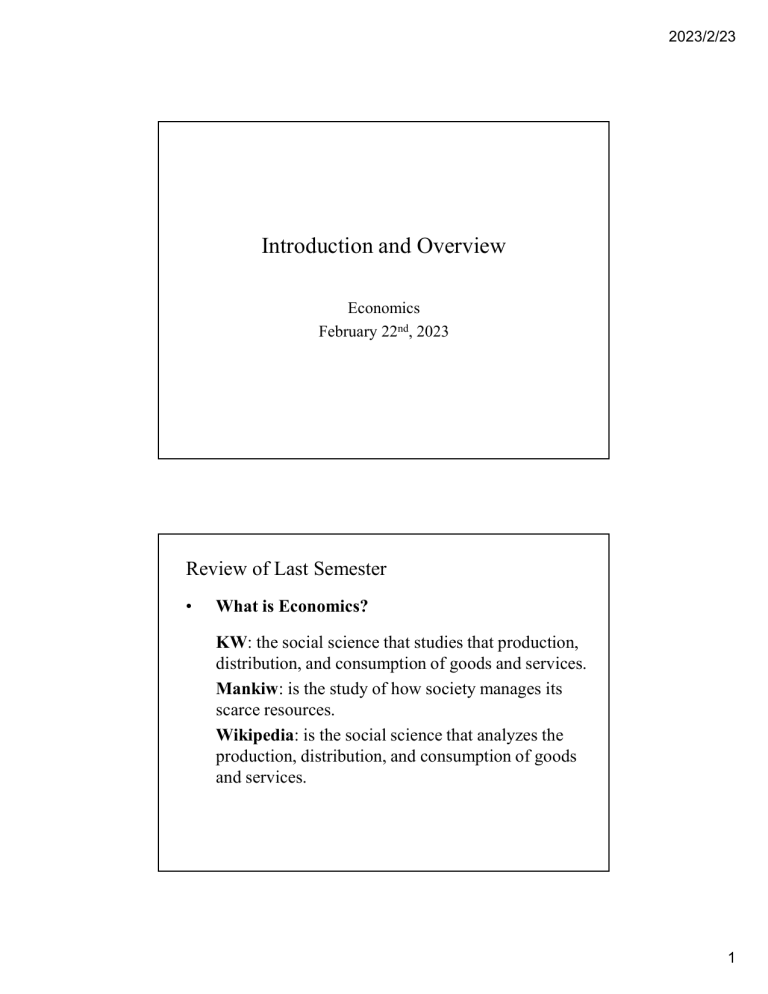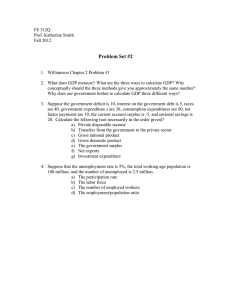
2023/2/23 Introduction and Overview Economics February 22nd, 2023 Review of Last Semester • What is Economics? KW: the social science that studies that production, distribution, and consumption of goods and services. Mankiw: is the study of how society manages its scarce resources. Wikipedia: is the social science that analyzes the production, distribution, and consumption of goods and services. 1 2023/2/23 Review of Last Semester • Fundamental Principles − Individual choice − Interaction of individual choices − Economy-wide interactions (How the economy works as a whole) Review of Last Semester • Fundamental Principles Individual choice Microeconomics Resource scarcity, therefore, tradeoffs. Opportunity cost is the true cost. “How much” decision made at the margin. People respond to incentives. Interaction of There are gains from trade. individual Markets usually lead to efficiency. choices Government can sometimes help. 2 2023/2/23 Review of Last Semester • Fundamental Principles Economywide interactions; How the economy works as a whole Macroeconomics (KW starting from Ch 21) One person’s spending is another’s income. Standard of living depends on the economy’s ability to produce goods and services. Overall spending sometimes doesn’t match what the economy is capable of producing. Government policies can change spending. Prices rise when printing too much money. Society faces a short-run tradeoff between inflation and unemployment. Review of Last Semester • Microeconomics vs. Macroeconomics Microeconomics studies how people make decisions and how these decisions interact. Macroeconomics studies the economy-wide ups and downs, such as inflation, unemployment, and economic growth. 3 2023/2/23 Review of Last Semester • Micro or Macro? − − − − − How should I spend my red envelope money? How much should Starbucks sell its latte for? What’s the overall price level in Taiwan? Should you get a job and quit school now? How many people are unemployed in Taiwan last month? − Why is average income relatively higher in Singapore than in Taiwan? What Does Macroeconomics Study? Recessions [Def.] Periods of falling real GDP. [Def.] Periods of economic downturn when output and employment are falling. 0 10000 20000 30000 40000 U . S . G D P p e r c a p ita i n m illio n s o f 2 00 5 d o lla rs 18 00 18 20 1 84 0 1 86 0 1 88 0 1 90 0 y e ar 1 92 0 1 94 0 19 60 19 80 20 00 4 2023/2/23 What Does Macroeconomics Study? self-regulating Keynesian monetary, fiscal policy The Great Recession The Great Depression of the 1930s What Does Macroeconomics Study? • Why we care? The pain of recession. − Firms suffer losses − Unemployment − Reduced standard of living 5 2023/2/23 What Does Macroeconomics Study? LR growth Keynesian monetary, fiscal policyal policy Business cycle OUTLINE: (tentative) Week (Date) 1 (Feb. 22nd) 2 (Mar. 1st) 3 (Mar. 8th) 4 (Mar. 15th) 5 (Mar. 22nd) 6 (Mar. 29th) 7 (Apr. 5th) 8 (Apr. 12th) 9 (Apr. 19th) Topic Introduction GDP and CPI Unemployment, Inflation LR Economic Growth Savings, Investment Income, Expenditure Holiday – No session Midterm Exam AD, AS KW5 21 22 23 24 25 26 27 6 2023/2/23 OUTLINE: (tentative) Week (Date) 1 (Feb. 22nd) 2 (Mar. 1st) 3 (Mar. 8th) 4 (Mar. 15th) 5 (Mar. 22nd) 6 (Mar. 29th) 7 (Apr. 5th) 8 (Apr. 12th) 9 (Apr. 19th) Topic Introduction GDP and CPI Unemployment, Inflation LR Economic Growth Savings, Investment Income, Expenditure Holiday – No session Midterm Exam AD, AS KW5 21 22 23 24 25 26 27 OUTLINE: (tentative) Week (Date) 1 (Feb. 22nd) 2 (Mar. 1st) 3 (Mar. 8th) 4 (Mar. 15th) 5 (Mar. 22nd) 6 (Mar. 29th) 7 (Apr. 5th) 8 (Apr. 12th) 9 (Apr. 19th) Topic Introduction GDP and CPI Unemployment, Inflation LR Economic Growth Savings, Investment Income, Expenditure Holiday – No session Midterm Exam AD, AS KW5 21 22 23 24 25 26 27 7 2023/2/23 OUTLINE: (tentative) Week (Date) 10 (Apr. 26th) 11 (May 3rd) 12 (May 10th) 13 (May 17th) 14 (May 24th) 15 (Mar. 31st) 16 (June 7th) 17 (June 14th) 18 (June 21st) Topic Fiscal Policy Money, Banking Monetary Policy Inflation, Deflation KW5 28 29 30 31 Extended Topics 32, 33 Final Exam TBA TBA POP QUIZ 1: Which of the following is NOT a macroeconomic topic? (A) Government’s role. (B) Pricing strategies. (C) Unemployment. (D) Overall spending. 8 2023/2/23 Macroeconomics and the Measures Economics February 22nd, 2023 Gross Domestic Product, GDP [Def.] The market value of all final goods and services produced in an economy during a given period of time. 9 2023/2/23 Gross Domestic Product, GDP [Def.] The market value of all final goods and services produced in an economy during a given period of time. − market value: use market prices to add up different goods and services. Gross Domestic Product, GDP [Def.] The market value of all final goods and services produced in an economy during a given period of time. − all that are sold legally in markets. − exclude: home production, illegal transactions. 10 2023/2/23 Gross Domestic Product, GDP [Def.] The market value of all final goods and services produced in an economy during a given period of time. − final goods and services: those sold to the final/end users. − intermediate goods and services: those will be used as inputs for production of final goods and services (not included to avoid double counting). Gross Domestic Product, GDP [Def.] The market value of all final goods and services produced in an economy during a given period of time. − produced during the given period of time, not transaction of items produced in the past. 11 2023/2/23 Gross Domestic Product, GDP [Def.] The market value of all final goods and services produced in an economy during a given period of time. − geographically, regardless of the nationality of the producer. Gross Domestic Product, GDP [Def.] The market value of all final goods and services produced in an economy during a given period of time. − usually a year or a quarter (3 months). − quarterly data are mostly seasonally adjusted. 12 2023/2/23 Gross Domestic Product, GDP • The Components of GDP − − − − Consumer spending or Consumption (C) Investment spending or Investment (I) Government purchases (G) Net exports (NX or X − IM) Gross Domestic Product, GDP • The Components of GDP − Consumer spending or Consumption (C) spending by households on goods and services, except purchases of new housing. − Investment spending or Investment (I) − Government purchases (G) − Net exports (NX or X − IM) 13 2023/2/23 Gross Domestic Product, GDP • The Components of GDP − Consumer spending or Consumption (C) − Investment spending or Investment (I) spending on productive physical capital (including household purchases of new housing) and changes to inventories. − Government purchases (G) − Net exports (NX or X − IM) Gross Domestic Product, GDP • The Components of GDP − Consumer spending or Consumption (C) − Investment spending or Investment (I) − Government purchases (G) spending on goods and services by governments. − Net exports (NX or X − IM) 14 2023/2/23 Gross Domestic Product, GDP • The Components of GDP − − − − Consumer spending or Consumption (C) Investment spending or Investment (I) Government purchases (G) Net exports (NX or X − IM) spending on domestically produced goods and services by foreigners (exports, X) minus spending on foreign goods and services by domestic residents (imports, IM). Gross Domestic Product, GDP • The Circular-Flow Diagram 15 2023/2/23 Gross Domestic Product, GDP • The (Expanded) Circular-Flow Diagram Gross Domestic Product, GDP • The (Expanded) Circular-Flow Diagram − restricted to the flows of money (the implied flows of goods, services, and factors of production go the other way around). − for any given box, the total flows of money out of it is equal to the total flows of money into it. 16 2023/2/23 Gross Domestic Product, GDP • Calculating GDP 1. Adding up total value of all final goods and services produced (summing the value added of each producer). 2. Adding up spending (C + I + G + NX) on all domestically produced goods and services. 3. Adding up total factor income earned by households from firms in the economy. Gross Domestic Product, GDP • Calculating GDP -- A simple example Suppose there is a 4-company small economy that produces tomato, tomato sauce, pizza, and pasta, where tomatoes are used to make tomato sauce and tomato sauces are used to make pizza and pasta. 17 2023/2/23 Gross Domestic Product, GDP • Calculating GDP -- A simple example Tomato Tomato Sauce Pizza Pasta Mkt price $5 $50 $600 $250 Quantity sold 500 100 10 12 $0 $2,500(tomato) $2,500 $2,500 (Mkt) Value of sales Intermediate goods Wage, rent, and profit $3,200 $1,800 (sauce) (sauce) $2,800 $1,200 Total Expenditure Value added Gross Domestic Product, GDP • Calculating GDP -- A simple example Tomato Tomato Sauce Pizza Pasta Mkt price $5 $50 $600 $250 Quantity sold 500 100 10 12 (Mkt) Value of sales $2,500 $5,000 $6,000 $3,000 Intermediate goods $0 $2,500(tomato) $2,500 $2,500 Wage, rent, and profit $3,200 $1,800 (sauce) (sauce) $2,800 $1,200 Total Expenditure Value added 18 2023/2/23 Gross Domestic Product, GDP • Calculating GDP -- A simple example Tomato Tomato Sauce Pizza Pasta Mkt price $5 $50 $600 $250 Quantity sold 500 100 10 12 (Mkt) Value of sales $2,500 $5,000 $6,000 $3,000 Intermediate goods $0 $2,500(tomato) Wage, rent, and profit $2,500 $2,500 $2,800 $1,200 Total Expenditure $2,500 $5,000 $6,000 $3,000 $3,200 $1,800 (sauce) (sauce) Value added Gross Domestic Product, GDP • Calculating GDP -- A simple example Tomato Tomato Sauce Pizza Pasta Mkt price $5 $50 $600 $250 Quantity sold 500 100 10 12 (Mkt) Value of sales $2,500 $5,000 $6,000 $3,000 Intermediate goods $0 $2,500(tomato) Wage, rent, and profit $2,500 $2,500 $2,800 $1,200 Total Expenditure $2,500 $5,000 $6,000 $3,000 Value added $2,500 $2,500 $2,800 $1,200 $3,200 $1,800 (sauce) (sauce) 19 2023/2/23 Gross Domestic Product, GDP • Calculating GDP 1. Adding up total value of all final goods and services produced (summing the value added of each producer). 2. Adding up spending (C + I + G + NX) on all domestically produced goods and services. 3. Adding up total factor income earned by households from firms in the economy. Gross Domestic Product, GDP • Calculating GDP -- A simple example Tomato Tomato Sauce Pizza Pasta Mkt price $5 $50 $600 $250 Quantity sold 500 100 10 12 (Mkt) Value of sales $2,500 $5,000 $6,000 $3,000 Intermediate goods $0 $2,500(tomato) $2,500 $2,500 $2,800 $1,200 Total Expenditure 1. $2,500 $5,000 $6,000 $3,000 Value added $2,500 $2,800 $1,200 Wage, rent, and profit $2,500 $3,200 $1,800 (sauce) (sauce) 20 2023/2/23 Gross Domestic Product, GDP • Calculating GDP 1. Adding up total value of all final goods and services produced (summing the value added of each producer). 2. Adding up spending (C + I + G + NX) on all domestically produced goods and services. 3. Adding up total factor income earned by households from firms in the economy. Gross Domestic Product, GDP • Calculating GDP -- A simple example Tomato Tomato Sauce Pizza Pasta Mkt price $5 $50 $600 $250 Quantity sold 500 100 10 12 (Mkt) Value of sales $2,500 $5,000 $6,000 $3,000 Intermediate goods $0 $2,500(tomato) Wage, rent, and profit $2,500 $2,500 $2,800 $1,200 Total Expenditure $2,500 $5,000 $6,000 $3,000 Value added $2,500 $2,500 $2,800 $1,200 2. $3,200 $1,800 (sauce) (sauce) 21 2023/2/23 Gross Domestic Product, GDP • Calculating GDP 1. Adding up total value of all final goods and services produced (summing the value added of each producer). 2. Adding up spending (C + I + G + NX) on all domestically produced goods and services. 3. Adding up total factor income earned by households from firms in the economy. Gross Domestic Product, GDP • Calculating GDP -- A simple example Tomato Tomato Sauce Pizza Pasta Mkt price $5 $50 $600 $250 Quantity sold 500 100 10 12 (Mkt) Value of sales $2,500 $5,000 $6,000 $3,000 Intermediate goods $0 $2,500(tomato) Wage, rent, and profit $2,500 $2,500 $2,800 $1,200 Total Expenditure $2,500 $5,000 $6,000 $3,000 Value added $2,500 $2,500 $2,800 $1,200 3. $3,200 $1,800 (sauce) (sauce) 22 2023/2/23 EXERCISE 1: Trend of GDP per capita 0 10000 20000 30000 40000 U . S . G D P p e r c a p ita i n m illio n s o f 2 00 5 d o lla rs 18 00 18 20 1 84 0 1 86 0 1 88 0 1 90 0 y e ar 1 92 0 1 94 0 19 60 19 80 20 00 EXERCISE 1: Trend of GDP per capita • • • • Replicate the previous trend with Taiwan (or any country of your interest) GDP from the earliest year available to 2021. Indicate the recessions on your trend. Submit via the course website before Feb. 28th 23:59 2 points maximum. 23





